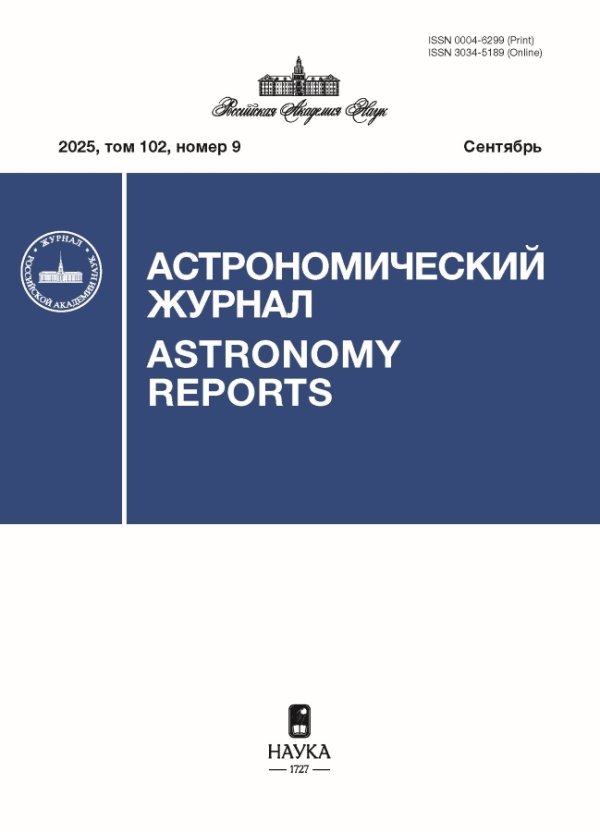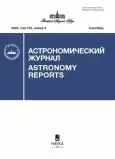Астрономический журнал
ISSN (print): 0004-6299
Cвидетельство о регистрации СМИ: № 0110223 от 08.02.1993
Учредители: Российская академия наук, Институт астрономии РАН
Главный редактор: Бисикало Дмитрий Валерьевич, академик РАН, д.ф.-м. наук, профессор, ORCID: 0000-0003-2025-5564
Периодичность / доступ: 12 выпусков в год / подписка
Индексация:
- Белый список (2 уровень)
- РИНЦ
- перечень ВАК
В журнале публикуются статьи по астрономии, в том числе по теоретической и наблюдательной астрофизике, планетарной астрофизике, физике Солнца, небесной механике, радиоастрономии, звездной астрономии, астрономическим методам и инструментам, а также обзоры книг, хроника, труды международных конференций.
Журнал основан в 1924 году.
Текущий выпуск
Том 102, № 9 (2025)
СТАТЬИ
Моделирование тепловой структуры протопланетного диска с помощью мультидиапазонного диффузионного приближения с ограничителем потока
Аннотация
В данной работе продолжен анализ модели расчета тепловой структуры аксиально-симметричного протопланетного диска, начатый в статье Павлюченкова (2024). В основе модели лежит известное диффузионное приближение с ограничителем потока (Flux Limited Diffusion, FLD) с отдельным расчетом нагрева прямым излучением звезды (далее — метод FLDs). В дополнение к описанной ранее модели FLDs с усредненными по длине волны непрозрачностями представлена реализованная нами мультидиапазонная модель mFLDs, где спектр теплового излучения разделен на несколько частотных диапазонов. Модель основана на неявной конечно-разностной схеме для уравнений диффузии теплового излучения, которая сводится к системе линейных алгебраических уравнений, записанных в гиперматричной форме. Предложен модифицированный метод Гаусса для обращения разреженной гиперматрицы исходной системы линейных уравнений. Описанные в статье результаты моделирования показывают, что радиальный профиль температуры из mFLDs в экваториальной плоскости диска обладает переменным наклоном в соответствии с расчетом методом Монте-Карло. Модель mFLDs также качественно воспроизводит неизотермичность распределения температуры по угловой координате вблизи экваториальной плоскости, что не обеспечивается методом FLDs. Однако между эталонными значениями температуры и результатами mFLDs остаются количественные различия. Эти отличия, вероятно, вызваны проявлением диффузионной природы приближения FLD. Показано также, что характерные времена прихода диска к тепловому равновесию в рамках модели mFLDs могут быть существенно короче, чем в FLDs. Это свойство необходимо учитывать при моделировании нестационарных процессов в протопланетных дисках в рамках моделей на основе FLD.
Астрономический журнал. 2025;102(9):745-762
 745-762
745-762


Критические параметры звезд в приближении однородной плотности
Аннотация
Рассчитаны модели звезд в приближении однородного распределения плотности. Для приближенного рассмотрения однородных изоэнтропических звезд использован вариационный метод, на основе которого рассчитаны точки потери устойчивости звезд в диапазоне масс от 2 до . Расчеты критических точек сделаны с учетом эффектов общей теории относительности. Уравнение состояния в диапазоне температур и плотностей K, г/см было взято из расчетов Имшенника и Надежина (1965). Критические параметры для значений энтропии и масс звезд, полученные в работе, отличаются от более точных значений, получаемых при численном интегрировании для более сложного распределения плотности, не более чем на 12%.
Астрономический журнал. 2025;102(9):763-773
 763-773
763-773


Характеристики суперземель и мини-нептунов
Аннотация
Более половины известных в настоящее время звезд имеют близко расположенные экзопланеты, промежуточные по размеру между Землей и Нептуном, называемые суперземлями и мини-Нептунами. Серия исследований California-Kepler Survey (CKS), в которой изучались данные миссии НАСА Кеплер, выявила бимодальное распределение планет с ( — радиус Земли) по радиусам — наблюдался недостаток планет с радиусами . В CKS не учитывались данные других миссий и экзопланеты, открытые нетранзитным методом. Все данные этой миссии ограничивались 2022 г. В настоящей работе исследовано распределение суперземель и мини-Нептунов с учетом всех известных к 2024 г. данных по экзопланетам из каталога НАСА. Были отобраны мини-Нептуны и суперземли с известными радиусами. Таких планет оказалось 937, из них планет с известной массой — 366. Поскольку радиус планеты может быть определен только транзитным методом, распределение по радиусам строится по данным транзитных планет, но, в отличие от CKS, берутся данные не только миссии Кеплер. Данные для остальных распределений выбраны независимо от метода их обнаружения и используемого телескопа. Нами показано, что современные данные наилучшим образом аппроксимируются распределением Гаусса с двумя пиками, которое описывает две популяции планет: каменистые (в дальнейшем суперземли) и экзопланеты с газовыми оболочками (экзопланеты, окруженные водородно-гелиевыми атмосферами, но состоящие преимущественно из тяжелых элементов — льдов и скальных пород, в дальнейшем — мини-Нептуны). Анализируется величина провала между популяциями в настоящее время. Показано, что провал заполняется равномерно с двух сторон, в CKS первый пик значительно меньше второго, то есть суперземель было меньше, чем мини-Нептунов. Возможно, за последнее время было открыто больше суперземель, из-за чего наблюдалась их нехватка в CKS. По теоретическим моделям зависимости массы от радиуса определен состав некоторых экзопланет.
Астрономический журнал. 2025;102(9):774-779
 774-779
774-779


Вероятные четырехкратные системы GI Cep и V548 Cyg
Аннотация
Проведен анализ изменений орбитальных периодов затменно-двойных систем GI Cep и V548 Cyg. Показано, что изменения периода каждой системы можно представить суперпозицией векового уменьшения и двух циклических изменений. Скорость уменьшения периода равна 3.73 × 10–7 сут/год для GI Cep и 2.38 × 10–7 сут/год для V548 Cyg. В GI Cep выявлено два циклических изменения с периодами 14.4 лет и 33.7 лет; в V548 Cyg — с периодами 5.4 лет и 43.8 лет. В GI Cep каждое из циклических изменений периода может быть следствием как присутствия дополнительного тела в системе, так и магнитной активности вторичного компонента. Система может быть как трехкратной, так и четырехкратной. Для V548 Cyg гипотеза магнитной активности не подходит. По всей видимости, это четырехкратная система.
Астрономический журнал. 2025;102(9):780-789
 780-789
780-789


Поиск эффектов ориентации в звездном ветре звезд Вольфа-Райе
Аннотация
Представлены результаты исследования корреляции между доплеровскими ширинами (FWHM) эмиссионных линий в спектрах тесных и ряда широких двойных звездных систем типа WR+OB и наклонением орбиты системы с целью поиска эффектов ориентации звездного ветра WR. Ширины исследованных линий не показывают корреляции с наклонением орбиты, существенных эффектов ориентации для ветра WR не обнаружено.
Астрономический журнал. 2025;102(9):790-809
 790-809
790-809


Характеристики экзопланет в транзитных системах HD 189733 и HD 209458: учет четырехпараметрического закона потемнения звезды в рамках трехмерной модели ее атмосферы
Аннотация
В работе проведен анализ высокоточных спутниковых кривых блеска экзопланет HD 189733 b и HD 209458 b. Определена зависимость радиуса экзопланеты от длины волны, вызванная рассеянием в планетной атмосфере, с использованием четырехпараметрического закона потемнения к краю, основанного на трехмерной модели звездной атмосферы. Показано что при использовании характеристик экзопланетной системы, одинаковых для всех длин волн, прежде всего наклона орбиты, а также при использовании четырехпараметрического закона с уточненным радиусом звезды увеличение радиуса экзопланеты HD 189733 b соответствует модели экспоненциальной рэлеевской атмосферы с характеристической высотой 380–400 км. В то же время характеристики атмосферы HD 209458 b в значительной степени зависят от принятого эксцентриситета системы.
Астрономический журнал. 2025;102(9):810-820
 810-820
810-820


Природа квазипериодических пульсаций излучения в жгутовых моделях вспышек
Аннотация
Жгутовые модели солнечных вспышек связывают явление квазипериодических пульсаций излучения вспышки с той параметрической катастрофой, которая возникает при выходе вершины скрученной магнитной петли (жгута) в корону. Резкое уменьшение внешнего давления заставляет продольное магнитное поле бессилового жгута стремиться к нулю на той магнитной поверхности, где ток меняет знак, при этом плотность азимутального тока и бессиловой параметр начинают неограниченно расти вблизи этой поверхности, приближаясь к разрыву. Токовая скорость электронов здесь неизбежно превысит скорость ионного звука, и возникнет плазменная неустойчивость. Рассеяние электронов на ионно-звуковых плазмонах резко (на 7 порядков) понизит проводимость плазмы и вызовет быструю, вспышечную диссипацию магнитной энергии жгута, т. е. уменьшение амплитуды поля и токов и, соответственно, расширение сечения жгута. Так будет сформирован первый пик излучения вспышки. При этом вращающий момент (torque), приложенный к каждому сечению скрученного жгута, будет сильно ослаблен в области энерговыделения. В равновесии torque должен быть одинаков вдоль всей длины петли, поэтому возникнет перенос потока азимутального поля альвеновскими волнами из ног петли к ее вершине. Выравнивание torque вдоль оси жгута возвратит жгут в первоначальное состояние, после чего формируется второй пик вспышечного излучения, и процесс повторяется несколько раз, пока запас связанной с токами свободной магнитной энергии во всей петле значительно не уменьшится. Колебания радиуса сечения жгута, сопровождающие пики его излучения, представляют собою специфический тип колебаний системы с переменной во времени жесткостью: в них сильно меняется напряженность магнитного поля, обеспечивающая возвращающую силу. Расчет таких колебаний позволяет добиться не только качественного, но и количественного соответствия теоретической модели и наблюдательных данных.
Астрономический журнал. 2025;102(9):821-832
 821-832
821-832


ПАМЯТИ В. А. КОТОВА
Астрономический журнал. 2025;102(9):833-834
 833-834
833-834













